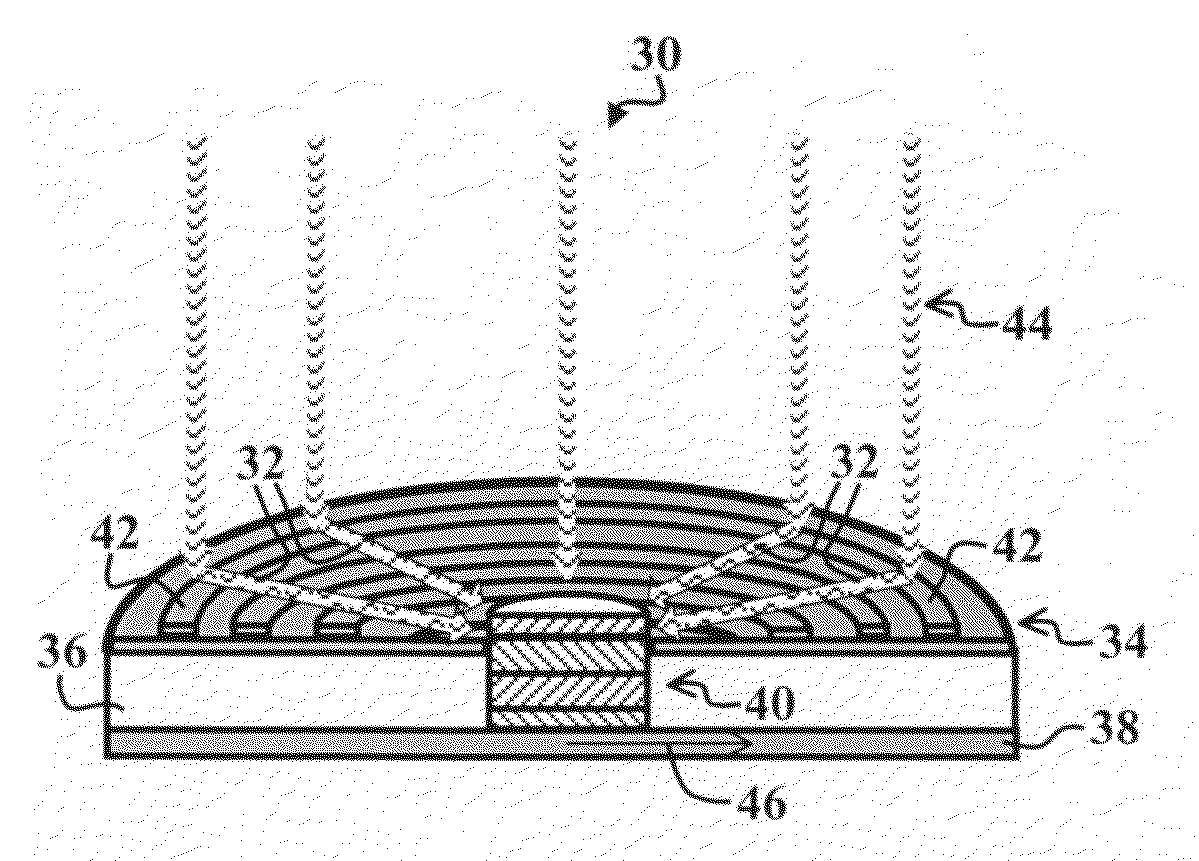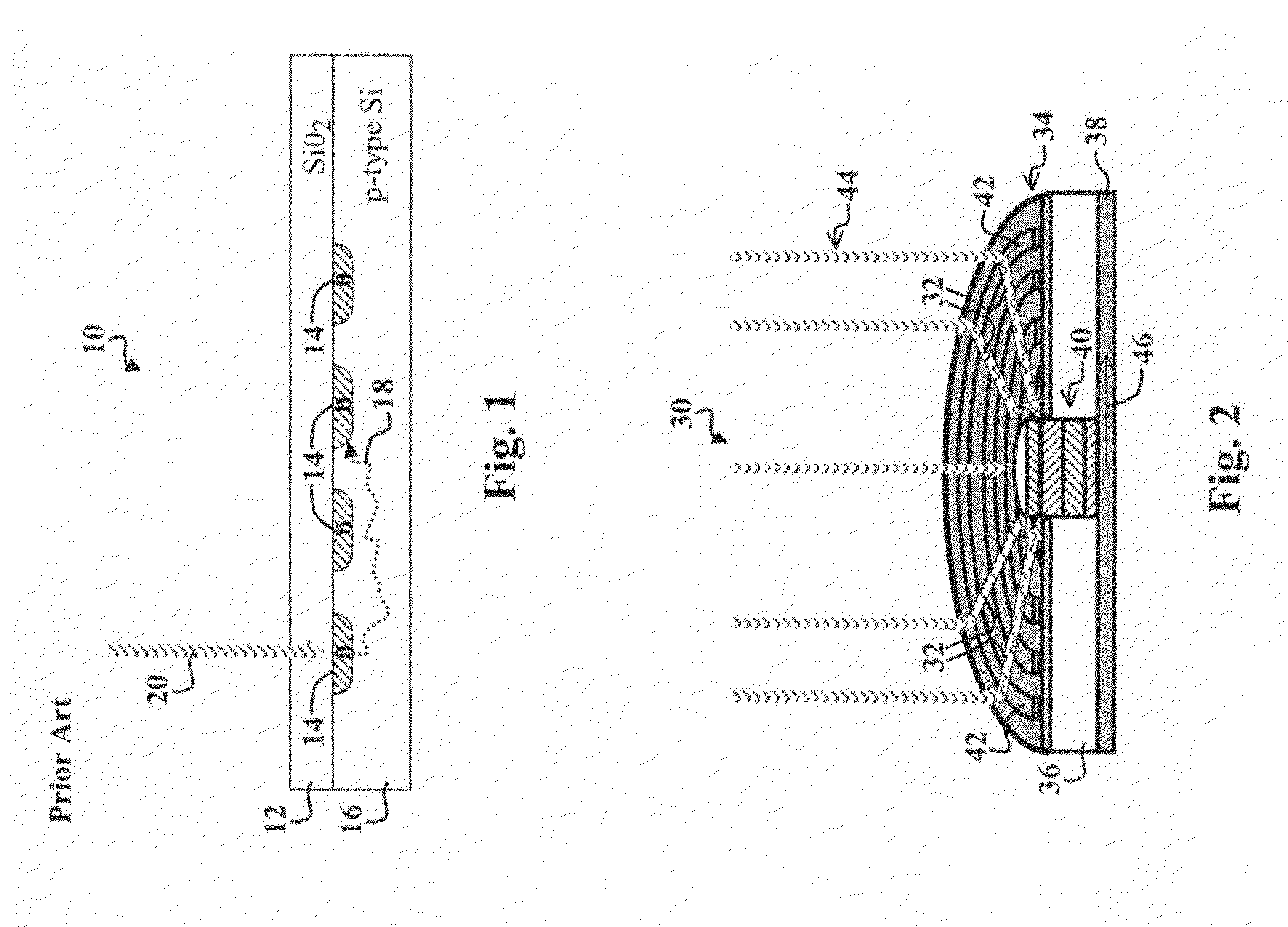Plasmon energy converter
a technology of energy converter and plasmon, applied in the field of energy converter, can solve the problems of increasing interference or crosstalk between detectors, reducing the efficiency of detectors at absorbing specific wavelengths of electromagnetic energy, and contributing to noise or output signal degradation, etc., to achieve the effect of facilitating coupling incident electromagnetic energy
- Summary
- Abstract
- Description
- Claims
- Application Information
AI Technical Summary
Benefits of technology
Problems solved by technology
Method used
Image
Examples
fourth embodiment
[0092]FIG. 7 is a cross-sectional diagram of a detector 140 adjusted for sensitivity to a particular wavelength of electromagnetic energy according to the present invention. The detector 140 includes a wavelength-tuned grating 142, with slots 152 cut therein to cause the detector 140 to be responsive to a certain wavelength of incident energy. The grating 142 is isolated from a p-type substrate 146 via an insulating spacer 150. Between the spacer 150, the grating 142 contacts an n-type region 144 formed in the substrate 146. The interface between the n-type region 144 and the p-type region 154 represents a pn-junction, in which an active region forms 154 during conversion of plasmons to electrical current. The detector 140 is partially surrounded by a plasmon reflector 84.
[0093]A central perforation 156 in the grating 142 opens above the n-type-region 144, and acts to confine the generation of electron-hole pairs to the n-type-region of the detector 140. This focusing and confinemen...
fifth embodiment
[0094]FIG. 8 is a top view of a superpixel 160, according to the present invention, which includes different detectors 140, 162, 164, which are tuned for sensitivity to different wavelengths or ranges of wavelengths of incident electromagnetic energy. The tuning of wavelength sensitivity is achieved by adjusting the spacing between grating grooves 152, 162, 172. Similar sensitivity adjustments may be made by adjusting the aspect ratios of the slots or slots 152, 162, 172, as illustrated in the graph 120 of FIG. 6.
[0095]The superpixel 160 represents a group of pixels, with each pixel tuned for a specific wavelength or range of wavelengths of incident electromagnetic energy. In the example superpixel 160 of FIG. 8, shorter wavelengths of incident energy are selected by use of shorter spacings between the grooves or slots 152, 162, 172 in the grating material 142. Hence, the superpixel 160 may simultaneously detect light of three different wavelength bands. Note that superpixels includ...
sixth embodiment
[0103]FIG. 9 is a top view of an array 180 of superpixels according to the present invention.
[0104]In an imaging array of photodiodes or other energy detectors, the ultimate limit for pitch is governed by the wavelength of incident light, since a photodiode with dimensions less than the wavelength will be nearly transparent to the incident light. Use of the enhanced photodiode architecture described herein may significantly reduce the ultimate limit for photodiode pitch.
[0105]Photodiode pitch limitations are often influenced by several other factors. One of the critical factors is the diffusion length scale of the electron-hole pairs, as illustrated by the random path 18 shown in FIG. 1. In a typical photodiode, some of the incident light is absorbed outside the depletion region at the n / p interface. The resultant electron hole pairs can diffuse randomly in any direction; and will have a high likelihood of being collected at the electrodes for a neighboring pixel if the pixel pitch ...
PUM
 Login to View More
Login to View More Abstract
Description
Claims
Application Information
 Login to View More
Login to View More - R&D
- Intellectual Property
- Life Sciences
- Materials
- Tech Scout
- Unparalleled Data Quality
- Higher Quality Content
- 60% Fewer Hallucinations
Browse by: Latest US Patents, China's latest patents, Technical Efficacy Thesaurus, Application Domain, Technology Topic, Popular Technical Reports.
© 2025 PatSnap. All rights reserved.Legal|Privacy policy|Modern Slavery Act Transparency Statement|Sitemap|About US| Contact US: help@patsnap.com



